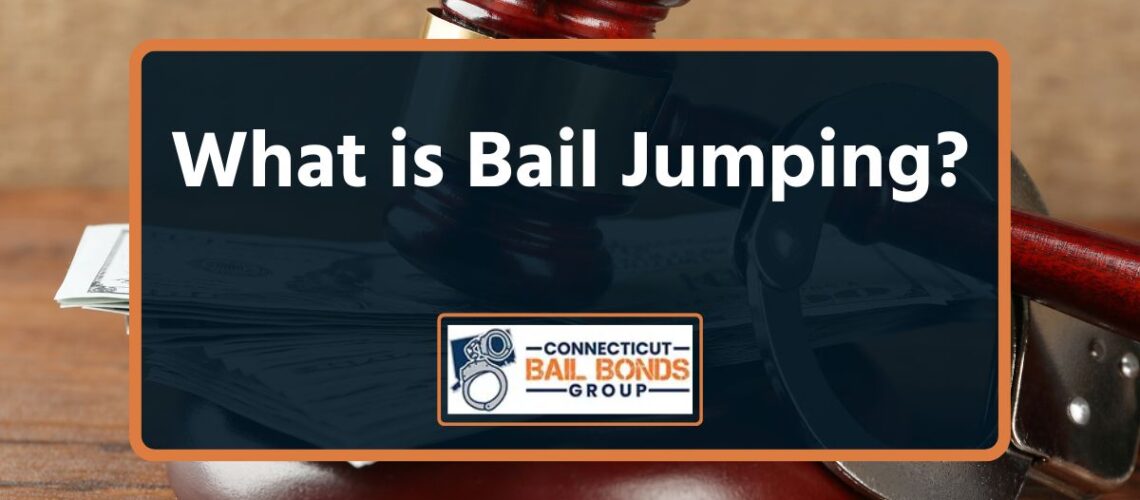Bail jumping, also known as “failure to appear,” occurs when a person released on bail fails to show up for their scheduled court appearance.
When someone is accused of a crime, they may be granted bail, a set amount of money that acts as a financial guarantee that the defendant must return for their court dates. If the defendant willfully fails to appear in court, the act is referred to as bail jumping and may attract severe legal consequences.
It’s part of the responsibilities of bail bondsmen to make sure their client shows up for their court appearance. So, it’s important you engage the services of a reputable and experienced bail bond company to ensure you understand your responsibilities while on bail and stay compliant throughout the process.
At Connecticut Bail Bonds Group, we’re fully committed to helping you or your loved ones secure release from custody as fast as possible. With over 15 years of experience in bail bond services in Connecticut, we have the required experience to guide you throughout the bail process and help you stay compliant. Book a free consultation with us today let’s discuss your needs and get started.
In this blog post, you’ll learn what is bail jumping and the legal consequences of bail jumping.
Understanding Bail Jumping

Bail jumping, also known as bail skipping, refers to the act of a person failing to appear in court as required after being released on bail. One of the primary purposes of bail is to guarantee that the defendant will appear on every scheduled court date. A bail jump occurs when this individual does not show up for one or more of these court appearances.
Note that bail jumping is closely related to failing to appear in court and can be used interchangeably in some instances due to their similarities, but these two concepts have clear differences.
Bail jumping specifically refers to when a defendant intentionally fails to appear in court as required, after being released on bail. On the other hand, failing to appear in court is a broader term that includes any instance where a person, whether on bail or not, does not attend a scheduled court proceeding. It includes cases where individuals are required to appear in court as witnesses, defendants, or for other legal matters.
Legal Consequences of Bail Jumping
Additional Criminal Charges
Bail jumping is often considered a separate criminal offense, and defendants may face additional charges for intentionally evading the legal process. Bail jumping on a misdemeanor is considered a misdemeanor while felony bail jumping is also considered a felony. The specific charges and the maximum penalties may vary by jurisdiction.
Generally speaking, misdemeanor bail jumping in the United States may attract additional fines, potential jail time, and an increased bail amount for future releases. It can also negatively impact the outcome of the underlying charge.
In Connecticut, bail jumping is addressed under Connecticut General Statutes Section 53a-172 for misdemeanors. Failure to appear in the first degree is considered a class D felony. The maximum penalties for conviction of a Class D Felony in Connecticut state court are 5 years in jail and a fine of $5,000.
In California, bail-jumping offenses are often charged under California Penal Code 1320 and 1320.5. For felony bail jumping, the individual may face up to one year in county jail and/or a fine of up to $5,000.
Forfeiture of Bail

When a defendant jumps bail, they forfeit the bail amount they posted to secure their release. This means the court keeps the money, and the defendant loses the financial collateral they or their surety provided.
Issuance of a Bench Warrant
Failure to appear in court as required may prompt the court to issue a bench warrant for the defendant’s arrest. This authorizes law enforcement to apprehend the individual and bring them before the court.
Increased Bail Amount
In some cases, if a defendant is re-arrested after bail jumping and seeks release again, the court may set a higher bail amount. This is intended to mitigate the risk of further non-compliance.
Revocation of Bail
Bail jumping may lead to the revocation of the defendant’s bail. This means that they lose the privilege of being released from custody pending trial, and they may be held in jail until their case is resolved.
Denial of Future Bail
Repeated instances of bail jumping may result in the court perceiving the person as a flight risk and a potential threat to the legal process. Hence, the court may be less willing to grant bail in future cases involving the same individual.
The Impact of Bail Jumping on the Judicial System

Bail jumping can have several significant impacts on the judicial system, creating challenges for the administration of justice and potentially affecting various stakeholders. The significant effects include:
Backlog of Cases
When defendants fail to appear in court, it can contribute to a backlog of cases. Courts may need to reschedule hearings and trials, leading to delays in the resolution of cases.
Strain on Resources
The efforts required by law enforcement to locate and apprehend individuals who have jumped bail consume valuable resources. This includes time, personnel, and financial resources that could be allocated to other law enforcement priorities.
Increased Workload for Courts
Courts must deal with the administrative burden of issuing bench warrants, managing the paperwork involved, and addressing the consequences of bail jumping. This increases the workload for court staff and can slow down the overall processing of cases.
Bail System Reevaluation
Instances of bail jumping may prompt a reevaluation of the bail system. Courts may reconsider bail conditions, amounts, and the criteria used for determining a defendant’s eligibility for bail to minimize the risk of non-compliance.
Public Perception of the Judicial System
High-profile cases of bail jumping can negatively impact public perception of the judicial system. Instances where individuals evade the legal process may affect trust in the system’s ability to ensure accountability.
Potential Legislative Changes
Repeated incidents of bail jumping may prompt legislative reviews and changes. Lawmakers may consider adjusting statutes related to bail, pretrial release, and the consequences for violating bail conditions.
Negative Impact on Victims and Witnesses
Bail jumping can negatively affect victims and witnesses who are waiting for their cases to be resolved. Delays caused by non-compliance can prolong the period of uncertainty and stress for those involved in the legal process.
More Emphasis on Pretrial Services
The judicial system may place greater emphasis on pretrial services and supervision to monitor and support individuals released on bail. This could involve increased use of electronic monitoring, check-ins, and other measures to boost compliance.
The Role of Law Enforcement in Preventing Bail Jumping

Law enforcement agencies play a crucial role in preventing bail jumping offenses and ensuring the smooth functioning of the criminal justice system. Some of the key responsibilities include:
1. Execution of Bench Warrants
When a defendant fails to appear in court, the judge may issue a bench warrant for their arrest. Law enforcement agencies are responsible for executing these warrants, locating the individuals, and bringing them into custody. This process often involves coordination between various law enforcement agencies, especially if the defendant has left the jurisdiction
2. Apprehension of Bail Jumpers
If a defendant fails to appear in court as required, law enforcement is responsible for locating, apprehending, and arresting the individual. They usually use investigative techniques, surveillance, and collaboration with other agencies to locate and apprehend those who violate their bail conditions.
3. Monitoring and Supervision
In some cases, law enforcement agencies may be involved in monitoring individuals released on bail. This can include compliance checks, ensuring that individuals adhere to any conditions set by the court, and taking appropriate action if violations are detected.
4. Coordination with Bail Bonds Agents
In cases where a bail bonds agent is involved, law enforcement may collaborate with these agents to locate and apprehend defendants who have jumped bail. Since the bail bondsmen post bail on behalf of defendants, they have a financial interest in ensuring their clients appear for scheduled court dates.
5. Extradition
If a defendant who has jumped bail crosses state or international borders, law enforcement agencies may be involved in the extradition process. This involves working with authorities in other jurisdictions to bring the individual back to face the pending charges.
6. Public Outreach and Education
Some law enforcement agencies engage in public outreach and education programs to inform the community about the consequences of bail jumping charges. By raising awareness, they aim to deter individuals from intentionally avoiding court appearances.
7. Risk Assessment and Pretrial Services
During the pretrial phase, law enforcement agencies may also be involved in assessing the risk posed by defendants. They provide information to the court to assist in determining appropriate bail conditions, taking into account factors such as the individual’s criminal history and potential flight risk.
8. Court Appearance Notification
Law enforcement may assist in notifying individuals of their upcoming court appearances. Ensuring that defendants are aware of their obligations and court dates can help reduce instances of unintentional non-compliance.
Real-Life Case Study of Bail Jumping

Let’s consider the State vs Hauk case decided by the Court of Appeal of Wisconsin. Kelly Hauk was charged with bail jumping on two different convictions. In her appeal, Kelly argued the sufficiency of the evidence, the jurisdiction of the circuit court, waiver of her right to a jury trial, and ineffective assistance of counsel, all on the first conviction. She further argued that on the reversal of the first bail jumping charge, the court should resent or modify the sentence on the second bail jumping charge.
In Kelly’s case, the court decided that although there’s sufficient proof that Hauk was guilty, she did not waive her right to a jury trial. Hence, the court ruled to reverse the first bail jumping charge and schedule a new trial for the first bail jumping. The court also decided that the reversal of the first bail jumping conviction would be a major factor in the sentencing for the second bail jumping conviction.
What can we learn from Hauk’s case?
In this case, although the defendant won the appeal, the adverse effects of the supposed bail jumping can be seen as the court would supposedly spend more time deciding the case and more resources due to the new trial schedule.
Conclusion
Bail jumping is a serious offense that may not only attract severe consequences on its own, but also affect the original charge negatively. Apart from affecting the defendant, bail jumping offenses also impact the legal system negatively as discussed in this blog.
If you or your loved ones are released on bail, it’s recommended to fully understand the bail conditions, including every scheduled court appearance. You can reach out to our bail bond experts at Connecticut Bail Bonds Group if you need clarity or professional guidance throughout your bail process. Book a free consultation with us today to get started.


